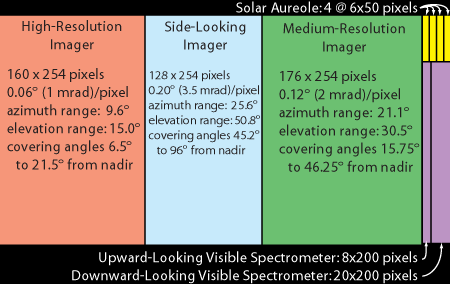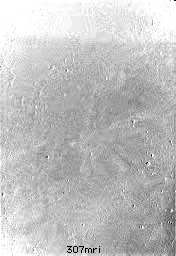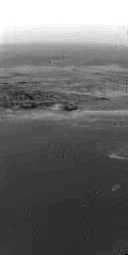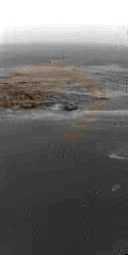Interpreting Huygens Images
After the January landing it
took me until July to figure out the big mystery of what I was looking
at: aquatic vegetation!
Space scientists never made the effort, and discarded the Huygens
images, the "meat in the sandwich" so to speak to tie all the other
data together, as meaningless. Anything one said to them about their
content was cast off with "the viewing conditions were poor" and "the
compression artifacting was awful." These defects don't change the
amazing and alien scenes recorded. When I emailed with reasons (not
only the images) that the landing area had to be liquid (very shallow
(3 inches?) at the touchdown point) and not dry ground, and also
predicted that an upcoming publication would indicate "the stuff of
life" on Titan's surface, I got this response:
"You can say you see pink aliens, or liquid, or cities of gold in the
images." - Ralph Lorenz, JPL
With a typical hand-held digital camera, one snaps a color picture of
familiar-looking Earth scenes in familiar types of Earth lighting at
relatively close range, and there is
usually not much question of what is being shown in the images. The
Huygens cameras sent us very coarse and mostly distant monochrome
images of an unfamiliar
new world at unusual (methane transparent) light wavelengths, and they
were highly compressed (read "made blurry") for
real-time transmission over a slow data link to the Cassini,
which was whizzing by overhead at 21,000 MPH and would be in radio
range just
four hours. Huygens thus had more the night vision of a bat than the
sharp eyes of
an
eagle.

Organization of Huygens's
single CCD optical
sensing chip. The
views and spectrums were fed to it via fiber-optic cables from the
lenses and instruments.
(For next time if anybody cares, I recommend four filters in quartet
squares of pixels: broadband and three methane-transparent wavelengths,
for deriving either color or monochrome images from. [Of course someone
else
may have an even better idea.] Hindsight is great - The landing itself
clarified what would give the best results, and unexpectedly showed
fascinating scenes in which color imaging would have been extremely
valuable! Before the landing, there wasn't even any guarantee that
there would be enough light to show anything at all, so Huygens brought
its own lamp to at least show the approaching landing! This proved to
be a waste of space and battery power, but who was to know?)
 The view through the three
imager lenses. The bottom edge of the HRI view looks almost straight
down and the HRI has a fairly high magnification. The top edge of the
SLI view looks just above the horizon at the sky and is the least
magnified, and so it sees the widest area. The views of the three
imagers overlapped slightly, and Huygens spun slowly as it descended
with the intent of seeing in every direction with overlapping views. Half the images
were lost owing to a software problem, but the plan was ingenious and
some areas and features were seen several times during the descent,
first through the HRI, then the MRI and finally through the SLI, all
viewing from different angles as Huygens descended. Various fine
"mosaics" - composite images - were created from the Huygens images.
The view through the three
imager lenses. The bottom edge of the HRI view looks almost straight
down and the HRI has a fairly high magnification. The top edge of the
SLI view looks just above the horizon at the sky and is the least
magnified, and so it sees the widest area. The views of the three
imagers overlapped slightly, and Huygens spun slowly as it descended
with the intent of seeing in every direction with overlapping views. Half the images
were lost owing to a software problem, but the plan was ingenious and
some areas and features were seen several times during the descent,
first through the HRI, then the MRI and finally through the SLI, all
viewing from different angles as Huygens descended. Various fine
"mosaics" - composite images - were created from the Huygens images.
While we all wish the images were better and in color, it is
something
of a miracle that on man's first attempt, Huygens traversed the vast
void to Saturn
successfully along with the Cassini, a velocities/doppler shift problem
that would have lost all the Huygens data was discovered and corrected
en route, it was aimed and released
successfully, entered the atmosphere of one of the most
mysterious and unknown worlds in our solar system intact, descended by
parachute successfully, and landed intact, while successfully
transmitting half its data during descent and after landing on Titan.
We
must
count
ourselves lucky we have any pictures from this distant world at all in
the early 21st century,
and we have them of an amazing shallow seascape! Consider that about
1/2 of all
Mars landers have failed, and Mars is much better known than Titan was.
But these low-quality, monochrome images present us with something
of a
puzzle. The
Huygens pictures were expected to be adequate to identify land from sea
(evidently they aren't!) and to show us grosser surface geology. In
order to get full value of the many fine-detail and exceptionally
interesting features Titan offers us in so many images, they must be
carefully scrutinized and, where possible, compared to other images
showing the same features or scene from different altitudes and angles.
(Note: I am going to refer to the liquid methane - seas, lakes, rivers
- as "water" for simplicity. Any actual water on Titan is a form of
rock.)
It's Very helpful to magnify the images by two for viewing and
study,
and to download the zip archive copies of the actual raw images
(link on title page) and adjust the
contrast and brightness yourself. (The supposedly "raw" images
available at ESA and JPL are already "randomly" contrast enhanced, some
to a grotesque extreme, probably until the brightest pixel hit "white"
and the darkest one "black".)
There are certain small image features
in the same place from image to image, so obviously they originate with
Huygens itself. My best guess is condensation droplets of some liquid -
dew - on the window covering the lenses, picked up very high up and
then probably frozen
on until near ground level. That would be bad enough, but the strong
light contrast across a
"droplet" causes the entire 16 x 16 pixel block in which it resides to
fill with strong compression artifacts. The medium-rez imager is worst,
but the other two lenses are by no means free of these. (I thought for
a while these were meteor craters - and therefore the sea must be dry
or frozen over because it had craters on it - which shows how necessary
it is not to form an opinion based on
a
casual glance at one or two of the images.) In the MRI images, there's
a lighter band across the top. This would appear to result from fog or
frost on the imager window. It is easy to mistake this
top area for a shoreline. Indeed,
icing during entry into Titan's atmosphere was a listed concern of the
mission, and evidently it did happen: Huygens needed windshield wipers
or a window heater!

Compression
Artifacts Versus Real Image Data.
Bad as some of the image
compression
artifacts are, the Huygens images,
descending and landed, portray well the scenes they are viewing, and
the detail over much of each image is more or less down to the pixel
level. It is a mistake to simply attribute to image artifacting every
feature not immediately identifiable, especially the broad features
defining an image.
There are some good indicators to what's real and what isn't. First,
compression was done independently to 16 x 16 pixels image blocks. In
many images the boundaries between some of these blocks are quite
visible. One of the first things to look for are "features" that partly
or wholly fill one compression block and stop abruptly at its edge(s).
These are most likely artifacts, while features, even similar ones,
that continue into the next block(s) are almost surely true image data.
Compression artifacts bear a characteristic stamp of appearance, which
soon becomes familiar to the student of the images.
Often there is real image data crossing a badly artifacted block where
the appearance in that block is different from surrounding blocks, but
it can still be made out as being evidently a contiguous feature. Many
such features can be made out in 307mri, above, with the artifacts
modifying but not obscuring the real image features.
Common Elements of Huygens Image Scenes.
It may be helpful to enumerate
the various components that together make up a Huygens image scene,
especially when that scene shows the liquid methane sea.
* First and perhaps most conspicuous are the "dewdrops"
and the
image compression artifacts they create. One must, again, recognize
that it's a "splattered" window Huygens views its world through. At the
top of the MRI images, there is a hazy band that appears to be fogged.
Since the "dewdrops" and the fog don't evaporate, they are probably
frozen for most of the descent. In the
after-landing images, the "dewdrops"
are gone, perhaps rinsed off by a splash of the liquid on the surface.
Instead, there is a bright "overexposed" area along the left edge of
the SLI imager, perhaps (guessing) indicating some methane splashed
along the
edge of the window.
* The critical angle of total internal reflection of the methane
should be considered. Above this angle towards the horizon, one is
seeing brighter surface reflections off the liquid, while below it, one
is looking into the darker, yet very clear, liquid. This is easily
sorted by imager. The more vertical images of the hi-rez and medium-rez
imagers are looking downward below the critical angle, which for
methane is 52 degrees. As
Huygens gets closer to the surface, the side looking imager starts
seeing the sea surface more. While the critical angle of total internal
reflection isn't very clear owing to waves
and other surface disturbances, the SLI sea images
invariably look darker in something of a zone near the bottom than in
the rest of the image, and generally undersea features, where they are
visible at all, aren't very evident above this zone.
* Effects of waves and other surface disturbances. The methane
seems to be
so clear that waves are often not very visible, and in a few low-level
HRI images it can be hard to remember that Huygens is above the sea and
not in it. But when looking downward into the sea, they can have a
distorting effect on the scene. There is some evidence in low-level HRI
images that we are seeing faint reflections or refractions of features
seen elsewhere in the image, or even from off the edge of the image, in
places where they shouldn't be. In most HRI and MRI images,
a fat, dotty line meandering from one edge of the image to another is
probably the crest of a wave. Distortions of underwater features are
greatest at the wave crests, but owing to methane's lower refractive
index, distortion is less than under similar Earth water. In 307 above,
I believe I can make out
several waves forming horizontal-ish lines across the image. But they
are generally, as here, quite faint.
By viewing it enlarged, a very close look at image 698-SLI reveals
a sheer
of spray seen coming from what appears to be the stem of a plant as a
wave hits it from behind. The reflection of the spray is also
visible in the water, helping to confirm it's a real feature. The plant
stem trails off to the left with what seem to be multi-color spotted
leaves coming off each side on the water. The rightmost and closest
leaf looks like a gigantic "seal head", and it is in fact the feature
that first caught my attention and I said "Wow, whatever that is, it's
just not dead geology!"


(Although I speak of "interpreting Huygens images", after much
consideration the only conclusions I'm pretty sure of in this image
are: there's a liquid sea that seems to be flowing and has a rough
surface in places, there's spray, there are things floating on the sea
surface, and there are reflections.)
* Objects on the sea surface.
These include, especially, plant leaves and stems, and possibly spore
pods. They can be light or dark in shade compared to other image
features, and some plants look much darker than others. The "spore
pods" (and that's just a wild guess) look much like jellyfish, but the
two I've noticed seem to have a stem going to them.
* In images looking into the sea: more plant leaves and stems. In
several low-level HRI images, however, there's more excitement: animal
life is evident. There are things that look like a squid, fish, and
frog-like and newt-like creatures (or unusual fish). In certain places,
we may see
features on the bottom, while in other images the bottom is very plain,
but there are plant shadows lying on it. And scattered throughout,
features quite difficult of interpretation that could be plants, sea
creatures, or geology. (The more I look, the more it seems to me the
bottom itself is pretty smooth and featureless, and that any features
are things that aren't the bottom.)
* In images of land, the most common things in view are again
stems and leaves, of giant vines whose roots are in the sea, crawling
across the land, again in dark and light colors. Bright "islands" just
offshore appear to be such roots sticking out of the 'water'. On the
day of the landing, the dark vines crawling across the land were
mistaken for "rivers", and I personally also thought for a while the
straighter, light-colored stems looked like "roads", with "buildings"
that were actually leaves. (Oops!)
* If there is any animal life on the land, I haven't noticed it.
Notes on Image Colorizations
Since the images or features in them have been often difficult of
discernment and interpretation, I occasionally "colorize" some objects
in the hope that what I think I see may be more easily seen by others.
I generally
put the original uncolorized image next to the colorized one for
comparison. Every effort is made to simply add color to existing
features rather than to accidentally create things that don't exist or
to distort those that do. But because of the lack of clarity of finer
Huygens image details, some artistic license is required in the making
of any attempt. The colorizations are thus imperfect at least to the
extent that the original image is vague, and certainly often more so.
When one color, eg green, is increased, the other colors, red and-or
blue, are correspondingly decreased so that the grey-scale brightness,
numerically speaking, remains the same. This retention of identical
brightness is not always entirely as discerned by the eyes, however,
which are most sensitive to green and least sensitive to blue. These
subtletys are beyond my power of objective judgement, so I don't try to
take them into account.
With Huygens having taken only monochrome images, and with even the
limited spectrographic information received being unavailable so far
AFAIK, the true colors are largely unknown, and I tend to use colors
that are more familiar to earthly eyes. In a sense, colors aren't what
we expect on Titan anyway unless we lit the scene with Earthly
floodlights, because the methane vapour in the atmosphere removes many
of the colors our eyes see, but is transparent in various
near-infra-red bands that eyes adapted for color vision on Titan would
undoubtedly see.
My intent, however imperfectly realised, is always to
clarify and point out what Huygens appears to have shown us as well as
I can discern it,
not to mislead or exaggerate: There's no shortage of astonishing
surprises as it is!
August 14, 2005
Rev Sept 9 2005 (added Common
Elements of Huygens Image Scenes)
Rev Sept 11 2005 (added Notes on
colorization)
Rev Oct 17th 2005 (added Huygens Imager info and diagrams - how could I
have neglected to include these!?)
Rev Nov 16th 2005 (correction of mistaken interpretation of the
brighter band in the MRI images, and a few misc. wording changes)
Copyright 2005 Craig Carmichael all rights reserved.





